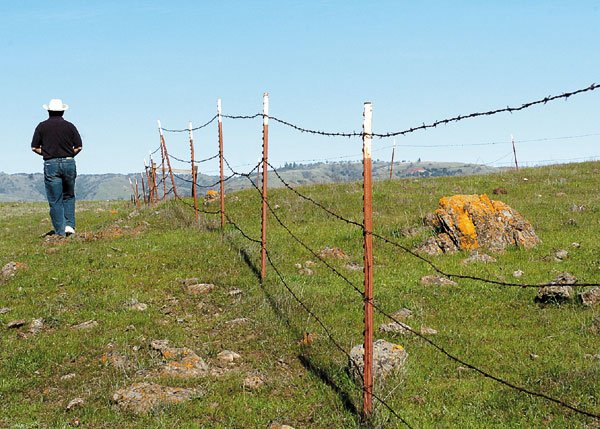Multiple agencies and nonprofit groups cooperate to preserve
open space
Winding, tree-lined Hecker Pass. Rolling foothills leading to the Santa Cruz Mountains. Dark brown earth seeded with garlic and peppers, stretching across the valley floor.
A sea of natural beauty surrounds South Valley residents and provides refuge for neighbors to the north, who have long since paved over their farms and clumped house on their hillsides.
But with each passing year, the landscape that gives South Valley its unique identity faces creeping pressure from development.
Westfield, a national mall developer, for instance, hopes to convert 119 acres of east Gilroy farmland into an outdoor mall within four years. Landowners in Coyote Valley hope to develop 6,800 acres and bring 75,000 people to the region during the next few decades. An Indian tribe and its San Diego-based development partner hope to bring housing to Sargent Ranch – 6,500 acres of untouched hills and streams just south of Gilroy.
Roughly 75,000 acres of county land are at high risk of development in coming decades, according to a 2006 study by the nonprofit Greenbelt Alliance.
In the face of such development pressures, a handful of government and nonprofit groups are trying to save South Valley’s natural resources, one farm and one hillside at a time.
“If you look at what San Jose looks like now and you anticipate in 50 years, Morgan Hill and Gilroy are going to look the same way, that’s a big issue,” said Craige Edgerton, executive director of the Silicon Valley Land Conservancy. “The only remaining rural agricultural land and open space is in South County. And that is the main focus of our preservation efforts.”
The conservancy has focused especially on preserving farmland along the Pajaro River, in the most southern reaches of Santa Clara County and northwest San Benito County. There, the Conservancy has purchased so-called conservation easements on roughly 1,160 acres of prime farmland. The easements, which cede control over the development rights of property to the conservation group while leaving farmers free to continue working the land, are among the most popular form of preservation strategies. The cost of an easement is typically 50 to 70 percent of the price to buy land outright.
Edgerton is the sole employee of the agency, which lives on a modest budget of $150,000 annually. To conserve land, the group leverages funds from corporations, private foundations and government agencies, among others. Its efforts also involve more than slapping a protective legal shield around land.
In Coyote Valley, for instance, the conservancy group is orchestrating a program to maintain niche agriculture by promoting a unique brand, akin to the name recognition enjoyed by Napa Valley wineries. Edgerton is also training docents to lead free nature hikes during the April wildflower blooms on Coyote Ridge. The area, just east of the Coyote Creek Golf Course off U.S. 101, is a hotbed of endangered plant and animal species, including the California tiger salamander, the California red-legged frog and the golden eagle. Edgerton said such activities are as central to the conservancy’s mission as the preservation of land.
“I think that people have a basic need to connect with nature and not feel closed in,” Edgerton said. “And that’s a fundamental need we all have at some level, even if you go out once a year for a picnic or a hike. You need a place to get away from the rat race that we’re all in, and those places have to be close by.”
The conservancy isn’t the only group that lives by that creed.
One government agency has spent 12 years and $36 million preserving the region’s natural resources. Since its founding in 1995, the Santa Clara County Open Space Authority has protected 12,933 acres. The group is an independent government agency that relies on a $12 parcel tax to raise funds for preservation. The agency returns 20 percent of the roughly $4.1 million it collects each year to its member cities, which use the funds to create nature trails, public parks and other open spaces. The remainder of the funds go to preserve new land and maintain the conservancy’s existing lands. And when it comes to preservation, the OSA does not only look to slap a legal shield around property, according to OSA General Manager Patrick Congdon.
“I’m a huge supporter of ‘working landscapes’ – when ranchers and farmers continue using land,” Congdon said. “In some cases, it may be better as protection to have a rancher graze it or produce an agricultural product.”
Most recently, the OSA protected 233 acres in east San Jose, and is now looking to preserve 574 acres east of Gilroy, off Canada Road. The latter site contains a portion of the historic DeAnza Trail.
In the long term, OSA has its sights on “two or three large properties that will cost millions and millions of dollars to purchase,” Congdon said, but the agency is holding back until it resolves a legal challenge targeting its funding. In 2001, the Silicon Valley Taxpayers’ Association sued the OSA after voters narrowly approved a $20 parcel tax to supplement the original $12 tax. The state supreme court will decide in the next few years whether to uphold lower court rulings favoring OSA’s ability to collect the additional tax. In the meantime, the agency is playing it safe and not touching the $32 million that has accrued in its bank account since 2001.
If it loses the case, OSA will have to pay back the money and limit its operations to maintaining its existing stock of lands.
The sewers were overflowing…”
Though many of their growth policies have been criticized, the cities of Gilroy and Morgan Hill have also taken steps to protect land. In Morgan Hill, city leaders recently passed an urban growth boundary aimed at preventing the city from spilling into any more green areas. The city also has a population cap that tamps down on development. The measure is so strict that the city, now roughly 33,000 people, will not reach Gilroy’s current population of 50,000 until after 2020.
The slow growth mentality in Morgan Hill dates back several decades. When former Mayor Dennis Kennedy arrived in Morgan Hill in 1978, he said the “schools were overcrowded and the sewers were overflowing.”
“Many of us had moved here from San Jose and other cities where there were lots of problems associated with high density development,” Kennedy said. “A lot of people wanted to slow things down and protect our natural resources, and that’s what happened with Measure E,” which capped the city’s population.
A so-called “urban limit line” crept into the city’s growth debates in the early 1990s, but was sidelined during a decade marked by budget crises and political turmoil. In 2001, just before the technology industry imploded, the city began serious planning efforts to establish an urban limit line. Six years later, the city passed the measure – albeit by excluding the southeast portion of the city where landowners are eager to cash in on their property.
“It’s a mixed bag,” said Kennedy, reflecting on nearly 30 years of growth debates in Morgan Hill. “We’ve had some successes and some failures, but overall, had we not done what we’ve done, we’d look a lot more like Los Angeles. I wouldn’t see the green hills I’m looking at now out my window.”
The growth debates that shaped Morgan Hill have started seeping into Gilroy, though the city has yet to seriously discuss a permanent boundary. And though it has resisted efforts by regional land-use officials to set a permanent edge around the city, local leaders have taken some innovative steps to control growth, both inside and outside the city. For instance, officials are now requiring a high-level of pre-planning for vast tracts of land, to ensure that new housing developments include plenty of parks and nature trails. They also have instituted a farmland preservation policy which requires one acre of farmland to be preserved for every acre brought into the city for development.
Some Gilroy officials, such as Councilman Russ Valiquette, have argued that an urban limit is a moot point for debate, since a boundary set by politicians is always subject to change by future politicians.
Edgerton agreed that the only way to truly protect land is to purchase it or buy its development rights. But he said the value of an urban limit line should not be underestimated. By drawing a line in the sand, City Hall can send notice to landowners outside city limits that they will not be able to cash in on their property by waiting a decade or two for the city’s borders to engulf them. Such policies have a cascading effect, Edgerton said, increasing the willingness of landowners to conserve their property and lowering costs to preserve that land for groups like the land conservancy and OSA.
“That’s why those urban growth boundaries are so necessary,” Edgerton said. “Landowners of course will scream about property rights violations, but cities have a right to define their boundaries.”
Gilroy Mayor Al Pinheiro admitted the city has never seriously debated a permanent urban edge. The city is the only one in Santa Clara County that has refused to join the OSA. The last time the subject was debated in 2004, officials said they would did not want to agree to impose tax money that could be spent in other parts of the county. Some also suggested that, even without their participation, OSA will be forced to spend money in South County – the home of much of the county’s remaining open space. In the years since that debate, more than 2,000 homes have been approved for construction on hundreds of acres in southwest Gilroy and off Hecker Pass. To the east, Westfield Corporation is now seeking city approval to build a 1.5 million square foot shopping mall modeled on a traditional American downtown.
Though the Llagas Creek forms a natural boundary to the east, city leaders have never decided that they would not skip past the waterway and seek to build toward the eastern foothills. Pinheiro said the time may be coming for that debate.
“Go north of us and you’ll see why we should care,” he said. “Go to San Jose and you’ll see. We’re all trying to leave our kids a better area to live in than our counterparts to the north of us, where the need for more and more development led them to pave over areas that should have been saved. You can build more buildings, but you cannot grow more land. You need to find that balance.”
How the OSA Stretches its Dollars
When it comes to getting a bang for its buck, one local governmental agency makes sure its dollars stretch far and wide.
The Santa Clara County Open Space Authority has spent nearly $36 million over the last 14 years to preserve nearly 13,000 acres of land – from farms and ranchlands in the country to nature trails and parks in nearly all of the county’s cities.
Preserving Santa Clara County’s open spaces is not just a job for Patrick Congdon, OSA’s general manager.
“Having grown up in Santa Clara Valley, I would jump up over my backyard fence and I’d be in a prune orchard,” he recalled.
“Then I could stroll down to Coyote Creek and catch crawdads. It was a natural area that teaches us about our own lives.
“It was a great evnironemnt to grow up in. I raised my kids that way, and I think every family should have an opportunity to raise their kids in that environment.”
The agency has seen some recent successes ensuring that future generations will have a chance to grow up close to nature. In June 2006, OSA orchestrated the $1.1 million purchase of 38-acre Jackson Ranch in South County and its resale to Santa Clara County Parks and Recreation.
County officials plan to restore buildings at the site and eventually allow public access to the ranch, located on the east side of Anderson Reservoir. The OSA also helped secure an agricultural easement – by contributing $500,000 toward purchasing development rights – for 510 acres of farmland southeast of Gilroy.
The easement will be held by the Silicon Valley Land Conservancy and the land will continue to be used for agricultural production.
Preservation is rarely cheap, and OSA relies on a $12 annual parcel tax on homes in member cities to finance its $4.1 million annual budget. With the exception of Gilroy, all the cities of Santa Clara County have voted to join the OSA.
In turn, the agency returns 20 percent of its revenues to those cities to maintain nature trails, build parks and create other open spaces.
The remainder of the funds are used to maintain the agency’s holdings and purchase land or buy development rights to new land.
Former Morgan Hill Dennis Kennedy said that joining the OSA was “a logical thing to do.”
“We value open space and I think a majority of residents believe in that,” he said. “Each city had the option to vote on (the parcel tax) and it was a close vote.
“My experience has been that any new taxes are pretty controversial, so you have to have a pretty persuasive argument.”
Gilroy is the only city in Santa Clara County that has so far refused to support OSA.
Mayor Al Pinheiro disagreed with his colleague’s decision in 2004 to once again pass up the chance to join the OSA.
“I just think all of us working together would be better,” he said. “We need to be very vigilant to preserve our open space. We need to pay for it, but we can’t expect families who have paid for their land to give up their land just because we want to preserve it. We need it to pay a fair price for it.”
Though the agency has made some recent purchases in the Gilroy area, Congdon said it has not devoted as much of its efforts or funds as it could have because Gilroy has refused to join the group.
The result – as Gilroy expands, it may miss opportunities to preserve land by leveraging OSA funds.
The agency is holding back on purchases, however, until the state supreme court decides the fate of $32 million in parcel taxes dating back to 2001.
That year, an anti-tax group sued the OSA after voters narrowly approved a $20 parcel tax to supplement the original $12 tax.
Lower courts have ruled the OSA could legitimately collect the additional tax without a two-thirds majority of voter support.













